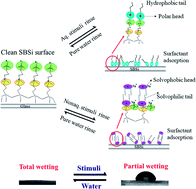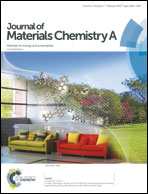Smart zwitterionic sulfobetaine silane surfaces with switchable wettability for aqueous/nonaqueous drops†
Abstract
Smart surfaces with switchable wettability for both aqueous and non-aqueous drops based on zwitterionic sulfobetaine silane (SBSi) have been fabricated. The wettability transition occurs from a total wetting (contact angle, CA ≈ 0°) to a partial wetting (CA as high as ∼75°) state. A surfactant solution (aqueous or non-aqueous) rinse (for 5 s) acts as a stimulus and the reversal of surface wettability is achieved simply by a pure water rinse. The reversible behavior of the switchable wettability of a SBSi surface can be observed for at least 100 cycles. Various cationic surfactants are used as stimuli for aqueous drops and anionic surfactants are employed for non-aqueous drops. This unique wettability-switching property is attributed to basal surfactant adsorption driven by electrostatic attractions between the charged surfactant head groups and zwitterionic groups of SBSi. Such rapid surfactant adsorption is also responsible for intriguing drop fission and dewetting phenomena, shown by stimulus drops cast on clean SBSi surfaces. Thus, this smart switchable wettability surface can be employed to fabricate intelligent devices for controlling mobility and sensing.



 Please wait while we load your content...
Please wait while we load your content...